Reinvention
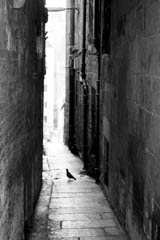 Edinburgh is the World’s only City of Literature, announced in 2004 by the United Nations from their central offices in Paris. Whilst the Gallic literati watched with restrained amusement, Scottish food, music and whisky were distributed. The bureaucrats wished to confer on Edinburgh a supreme label of approval, because its great writers maintain the interest of posterity and its modern writers are best-sellers. Edinburgh has always inspired writers, challenging them to capture its lightness and chase the dark secrets of disappearing wynds.
Edinburgh is the World’s only City of Literature, announced in 2004 by the United Nations from their central offices in Paris. Whilst the Gallic literati watched with restrained amusement, Scottish food, music and whisky were distributed. The bureaucrats wished to confer on Edinburgh a supreme label of approval, because its great writers maintain the interest of posterity and its modern writers are best-sellers. Edinburgh has always inspired writers, challenging them to capture its lightness and chase the dark secrets of disappearing wynds.
For centuries buildings have been commandeered and constructed to protect the city’s love affair with literature. The National Library is a stark and forbidding champion, whilst the Writers’ Museum sits out the years in narrow medieval dignity. In structural contrast, the Poetry Library is caught tight in a small courtyard, light falling through glass onto slim volumes. Although a seam of bibliographic splendour still runs through the Reference Room of the Central Library, the patter of medium-size feet has recently tarnished its splendour. Proliferating computer terminals encourage a passing crowd of web surfers, gaining valuable knowledge, perhaps, sending out a vacuous stream of self-promotion, more likely.
In any case, Edinburgh is a literary city that evolves, not caring whether it is applauded on the global stage. Whilst the City of Literature valiantly produces 25,000 free copies of R.L. Stevenson’s Kidnapped and arranges networking nights so industry types can get to know each other, the literary fringe growls. In Scotland, at every possible time of year, writes a local poet, ‘we know we’re fucked’.
The last quotation leads on nicely to the Parliament, where a small percentage of £430 million was invested in carving quotations into the building’s fabric. Do they confer cultural significance? Or perhaps their purpose is to distract from the riot of odd angles so disorientating to a close-up visitor. 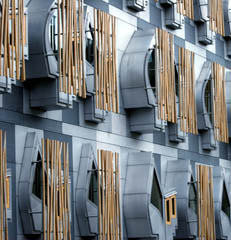 In any case, if the Parliament is desperate for literary endorsement they should try Shakespeare’s Macbeth: ‘fear not, till Birnam wood/ Do come to Dunsinane.’ I imagine a wood splattering itself across the main building in a fit of martial pique. They might also move onto a tragedy, if beams keep falling down unexpectedly.
In any case, if the Parliament is desperate for literary endorsement they should try Shakespeare’s Macbeth: ‘fear not, till Birnam wood/ Do come to Dunsinane.’ I imagine a wood splattering itself across the main building in a fit of martial pique. They might also move onto a tragedy, if beams keep falling down unexpectedly.
What such literary tokenism seems to forget is that writers have been known to care about such things as aesthetics. R.L. Stevenson nearly gave himself a coronary over the development of sprawling Victorian villas. Marketing phrases such as ‘reinvention’ occasion a nervous tick. It is hard to be passionate about something that breaks, in an ugly and often superficial way, from the past. Recently, I attended an event where the council representative talked enthusiastically about ‘freedom from (sic) expression’. His slip captured a bon voyeur vacuity that seems to be gripping the city. It seems that expression, in terms of saying something meaningful about life, is simply not a high priority. Harry Potter and overweening architecture certainly is.
I didn’t really notice this acceleration in rebuilding until developers got their hands on the old hospital site on Lauriston Place, near where I live. Suddenly it was as though my sensory perceptions had shifted, like when you learn a new word and then hear it all the time. I started to see the builders and the generic placards promising a ‘twenty-first century future’ – because of course, newness is always going to be better. Is that logical? Such progress is happening on a global scale. Cities rise in the night in China, or so the story goes, leaving solitary dwellings surrounded by huge pits, because one owner was obstinate and the developers legal, but only barely. 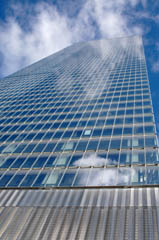 America still cares about who has the biggest skyscraper, a thrusting emblem of national strength or a substitute for phallic impotence… (I need an old-school feminist to take this further).
America still cares about who has the biggest skyscraper, a thrusting emblem of national strength or a substitute for phallic impotence… (I need an old-school feminist to take this further).
Such fiddling with fabric is necessary in the same way as our ever-expanding global population is necessary – to give individual countries an economic edge and to make sure they remain a force to be reckoned with. Population and development have a symbiotic relationship – so far, so simple. Demand stimulates supply and supply springs glass and steel from the cold, hard earth. Thus begins the reinvention of Leith, the old Royal Infirmary, West Port and the Royal Museum, to name but a few. Money changes hands.
I look around at this point. It may be the company I keep is unduly impoverished, but I can barely imagine who is going to live and work in all this newness. The desirable properties are not desirable if you don’t earn much or you are trying to grow a small business when Gordon Brown insists on hiking your basic tax rate. But this is a small aside. My imagination may be lacking but a friend assures me that Edinburgh has more than enough money to float the boat of ambitious property developers.
Why is it necessary to be fixated on modern buildings designed by trendy firms of architects? I am stiffly fond of the Royal High School building, which sits brooding over the Edinburgh cityscape. It is probably frivolous to judge buildings anthropomorphically, but the Parliament seems soulless, the school full of ponderous sentiment. People can – and do – become attached to places and be influenced by the buildings in which they live and work. Such was the basis for the National Trust for Scotland’s Little Houses Improvement Scheme, which has prevented the loss of many then derelict, traditional burgh houses, to the great benefit of the local community and indeed to Scotland as a whole.
One building I was never fond of is the old post office building on West Port. This is a hideous, ugly monster overly due for demolition. 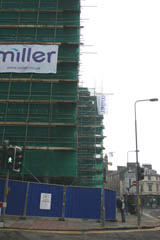 The only problem is that it will be replaced by a huge, modern office block that takes up more pavement space that the current incumbent. Roughly speaking, the superlatively bad will be substituted for the comparatively better. In real terms, this is not progress. I often find myself in West Port, visiting friends, frequenting bookshops or lusting after retro clothes in Herman Brown’s. True, it can be insalubrious, but the Salvation Army provides a bastion of hope and the wide-pavement means that the area is fairly open and girls can happily avoid packs of roving men who prowl at unseasonable hours in the afternoon.
The only problem is that it will be replaced by a huge, modern office block that takes up more pavement space that the current incumbent. Roughly speaking, the superlatively bad will be substituted for the comparatively better. In real terms, this is not progress. I often find myself in West Port, visiting friends, frequenting bookshops or lusting after retro clothes in Herman Brown’s. True, it can be insalubrious, but the Salvation Army provides a bastion of hope and the wide-pavement means that the area is fairly open and girls can happily avoid packs of roving men who prowl at unseasonable hours in the afternoon.
This is the pavement that will be no more. In the glorious near future, when the office workers have scurried home, the area will resemble a dark and unpleasant corridor. But still, it will be an improvement won’t it, shout the enthusiasts – not quite realising that there is more to the area than the strip joints on which their gazes fixate. In my utopian world, I would have built a smaller residential block with shops at ground level to provide a refuge for independent stores that can’t afford the rent on the high street. Such naivety, I admit, is laughable.
More practically, it does seem excessive to build another office block when there are so many sprouting nearby, from the Royal Infirmary site on Lauriston Place. One monolith will block 90 percent of daylight from adjacent Lister Housing Co-operative tenements – once proudly described as ‘the pearl’ of Scottish Housing Association properties. Another feature of the development is that glass and steel towers have been built cheek by jowl with retained old buildings, which are unattractive in some ways, but most interesting in others. 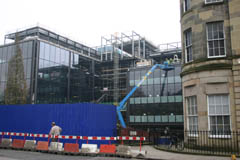 I suspect many of the units were constructed with a casual disregard for right angles. The new buildings are – new – and offer a great view of the Meadows. They also offer a not so great view for people on the far side of the Meadows. I don’t suppose that will impact on sales. It is a strange development and one that shows a great faith in the nation’s capacity to both make and spend money. Perhaps, as I walk past, I might learn something?
I suspect many of the units were constructed with a casual disregard for right angles. The new buildings are – new – and offer a great view of the Meadows. They also offer a not so great view for people on the far side of the Meadows. I don’t suppose that will impact on sales. It is a strange development and one that shows a great faith in the nation’s capacity to both make and spend money. Perhaps, as I walk past, I might learn something?
Then there are the fish. The much-beloved Royal Museum is home to two fish pools, many brutishly ugly fish, hundreds of stuffed animals and a huge number of inappropriate, obscure, and amazing exhibits. Until fairly recently they exhibited a whale’s penis on the ground floor near the door, a challenge to school teachers and a source of wonder for the males of other species. Next year the museum will close and it will reopen in 2011. 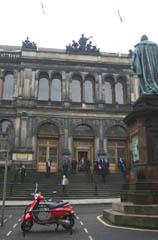 My only consolation is that the museum will have been ‘reinvented’ (according to a notice board) and, oh, the Connect and Communicate galleries will remain open – anyone with a short attention span and need for technological stimulation will be okay. So, this is a slightly premature farewell and thanks for all the fish. If I make it to 2011 in one piece, I will certainly drop by. If nothing else I miss the stuffed animals, particularly the armadillo, and I am curious as to what exactly ‘reinvention’ means.
My only consolation is that the museum will have been ‘reinvented’ (according to a notice board) and, oh, the Connect and Communicate galleries will remain open – anyone with a short attention span and need for technological stimulation will be okay. So, this is a slightly premature farewell and thanks for all the fish. If I make it to 2011 in one piece, I will certainly drop by. If nothing else I miss the stuffed animals, particularly the armadillo, and I am curious as to what exactly ‘reinvention’ means.
I think this last sentiment is one shared by a number of my generation. With only twenty something summers under our belt, we are starting to get a slightly queasy feeling about what is going to be left for us. Not in our name, we tell Tony Blair (he doesn’t listen). Not in our name, we could say, as the shape of progress becomes flabby and grandiose and slightly reminiscent of painting by numbers. The other day I met a doctor friend. Despite being a prize-winning Oxford graduate he had been unable to get an interview at Oxford for a training position. Apparently, he hadn’t ticked the right boxes and such unquantifiable qualities such as commitment, passion for the subject, adaptability and patience were sadly rendered irrelevant.
In the same way history is becoming irrelevant. It too, is unquantifiable because you cannot give marks out of ten for why certain buildings make you smile or think beyond the narrow confines of the present. If anything, they suffer because of history. Old buildings are ‘unsafe’, disabled access is difficult or computer screens are not available in at least two out of every three rooms (God forbid). Large reinvention projects will tackle these defects, without questioning whether their frameworks of judgment are ‘fit for purpose’, to pinch a cliché. No real thought will go into asking, what gives a city a sense of character, and whether subtractions and additions can alter this, slipping it from the bedrock of heritage on which its praise is so firmly fixed. At best, grand modern developments in Edinburgh will create space. At worst, they will crush the sense of history and character which has inspired so many writers.
Not in my name, I would like to say (but they don’t listen).
© Hannah Adcock
Photography courtesy of Hannah Adcock, and Scott Liddell and Roswitha-Schacht (morguefile.com)

Comments